Honda VFR800 VTEC
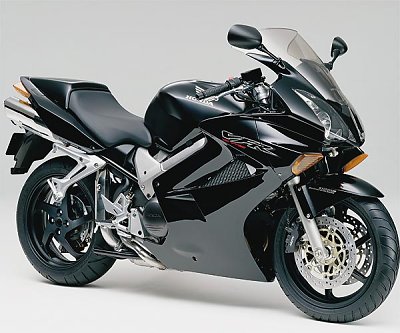
The all new Honda VFR800 copyright Simon J Evans
"All new?", you might askYes. This machine bears little resemblance to its predecessor, though of course it continues the tradition of a flexible, multi-purpose allrounder. The engine is the same RC45-derived v-four, but there have been a number of changes. The styling has been revamped, the new VFR looks more angular, more aggressive than its forbears. This is Honda's reaction to the arrival of bikes like the Aprilia Futura, an aggressively styled sports-tourer that utilises the 1000cc v-twin engine from their superbike model.
Triumph's Sprint ST had the match of the old VFR800, in fact its specification was so similar that some considered it to be a virtual clone, albeit with the distinctive 3-cylinder engine. The British company are providing the ST with an engine upgrade for 2002, with the bike inheriting the 955cc engine from the Daytona 955i.
Honda's R&D engineers know the sports-tourer / allrounder market is an important one. It's one the VFR has had virtually to itself for years. Apparent rivals have often produced more power or been more practical two-up, but the recent arrival of the Italian and British machines has seen a proliferation of bikes in this sector. So Honda have not rested on their laurels, and below is a brief description of the main changes that have been made to the world's greatest all-round motorcycle.
Engine
The fuel injected 16-valve block now has a form of 'variable valve control' which Honda calls Hyper V-Tec. While the name suggests this works like the system used on their cars - where inlet and exhaust valve timing is varied with rpm - it uses a different approach. It uses just two of the four valves in each cylinder at low rpm. This speed up the gas flow which increases torque.At about 7,000rpm a servo opens an oilway, and the pressure pushes a pin into the gap between the valve stem and the tappet on the two unused valves. The next time the cam lobe pushes on the tappet it opens the valves, and from here to the redline all 4 valves operate normally. This way peak power maintained, while torque is noticeably improved at lower revs. The graph at right (from the Honda UK website) demonstrates the benefit of the new system.
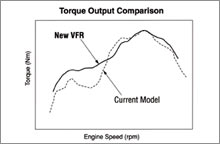 |
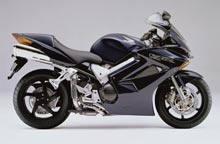 |
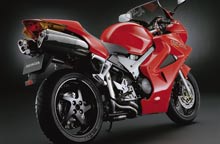
|
Other changes:
- 12-spray injectors - the injector in each cylinder now features 12
tiny jets instead of one. This allows more efficient combustion because the
widely dispersed fuel can atomise better.
- Chain-driven cams - the biggest shock. Honda have dropped the
gear-drive to the camshafts, and replaced it with a chain. This features a
patented new tensioner, which is claimed to be quieter than most systems.
- Clutch and gearbox - Honda have developed a new clutch, and the
gearbox features wider ratios, with a lower first gear. This is a result of
the wider torque band.
- Brakes - the CBS (Combined Braking System) has been tweaked. Compared to the old model the rear brake pressure is less when the front brake lever is applied.
Chassis
A beefier beam frame, designed to flex less under what might be called 'enthusiastic' riding conditions. A stronger swingarm pivot will also help give better feedback at speed. However, these improvements plus the other changes have actually led to an increase in weight. The new VFR is 3kg (6.6lb) up on its predecessor. While this might not mean a great deal to the sports-touring diehards, it is a disappointment for those who hoped Honda would perhaps release some of the 780cc engine's potential by losing some pounds.As the Fireblade demonstrated so clearly, a significant loss in weight is of far greater benefit than an increase in power. However, one suspects that Honda feel people will buy the machine for its undeniable flexibility, and they will surely hope that those looking for a lighter machine will avail themselves of one of the more sports-oriented CBR range.
Styling
The angular styling gives the VFR a more purposeful, less rounded appearance. The fairing and seat unit are noticeably more pointed. There is a central air intake in between the twin headlights, like the RC51. There are now two exhaust silencers, which exit just below the pillion seat unit. Practicality hasn't been sacrificed for these changes, as the handlebar-seat-footpeg distances are very similar to the previous model. The tank size has been increased by 1 litre (0.5 gallons) to 22 litres.Optional extras
You can now buy a VFR with ABS. In the USA this will cost an extra $1,000. There is hard luggage designed specifically for the VFR, though this will not be available until late Summer.Colours
For the UK the VFR is available in Force Silver Metallic, Black, Lapis Blue Metallic and Italian Red. In Australia it is Red and Blue. For the USA only Red (or Red). Boring! UK colours for 2004: Italian Red, Silver Metallic, Pearl Blue.Magazine impressions - first ride
UK weekly newspaper Motorcycle News was first with an in-depth report on the new machine in the flesh.The engine is more tractable in the mid- range than ever and there's a definite kick in the pants at 7000rpm when the VTEC system alters key valvetrain parameters to change the engine’s state of tune from favourable for mid- range torque to favourable for top end power.They noted that the handy remote rear preload adjusting knob only comes as standard on the £500-more-expensive ABS version of the bike. Non-ABS owners have to risk skinning their knuckles. There is also video footage added to the article.
The handling has also been improved without compromising the old model’s user-friendliness, the styling has been brought bang up to date and the linked brake system has been revised for the better too.
If you like the current VFR, you’ll like the new one even more. Even the briefest of rides shows Honda has addressed what it needed to with the VFR without upsetting the qualities thousands of riders love.
Bike magazine's verdict from the launch (Dec '01) was that it was a definite improvement on its predecessor. The feeling was that the V-TEC gives no real increase in top-end power, and they were not sure about the claimed midrange gain. Honda have taken a good look at the linked braking system and improved rider feedback no end.
The ABS system was considered the best system they had tested, allowing optimum braking performance, with no pulsing through the lever. The styling was described as "brave", and I guess it is quite a departure for what has always been considered a safe, "middle of the road" bike by many (or better than sliced bread by its admirers). It certainly looks more aggressive than its forebears. To summarise:
The new model is much tauter and sportier than the previous bike. It's a much more involving ride than the old bike. The steering is still neutral, it turns with the slightest of bar pressure and requires no body English histrionics to encourage the turn but it feels stable and secure. The front end provides enough feedback to let you know what is going on, and in this respect it's much better. This improvement has been achieved without having to make any significant compromises in the plush ride quality for which VFRs are renowned.The Telegraph newspaper's correspondent commented on its features but failed to pass a verdict:
Honda's VFRs have always been capable of producing astonishing performance and the new bike is no exception. Riders of 'proper' sportsbikes might look down their noses, but the fact is that 95 percent of the time they could ride the VFR faster and better than the bikes they are on now. The new bike is, in a sense, a return to the form of the last of the 750s, with a broader spread of power and more sporting bias. It offers 155mph performance, neutral handling and reassuring feel along with a centrestand, pillion seat and all day comfort. We don't deserve it.
The old bike handled well enough to keep up with sportier machines, but at high speeds the steering became rather vague. We're talking autobahn velocities here, but the opposition, including Triumph's Sprint ST, Ducati's ST4S and the Aprilia Futura, were superior. But the VFR now tracks true even on derestricted motorways. In itself that's not especially useful, perhaps, but it means that on British motorways the VFR feels solidly planted on the road.
On more sinuous and stimulating roads, the VFR's cornering is in the Ducati mould. Changing direction takes a bit of a heave on the bars, but the bike holds its line reassuringly and the firm (but compliant) suspension gets on with its job without troubling the rider.
Despite the sportier credentials, the ride quality and comfort have also improved, while the fairing create less wind noise and turbulence than before, too.
New VFR v VFR800 v Triumph ST
For their January 2002 issue Bike took a 1999-spec VFR and Sprint ST along to see how the newcomer measured up. To cut a long story short, here is part of the conclusion:The new VFR isn't a significant leap forward from the older bike. It isn't more comfy, it isn't faster and some people might say it only handles as well as the old VFR. The VTEC gives it a different engine character,which you'll either like or not, the brakes are better, as are the headlights. For us, the old bike has the edge in riding position and it somehow feels and looks better built.It seems the old VFR has not been entirely eclipsed. Some argue there wasn't much wrong with the old VFR750, and the improvements we were given in 1998 weren't a quantum leap. At least those who already own VFR800s shouldn't see their pride and joy lose its much envied resale value.
Truth is, both VFRs are fabulous bikes and you'd be hard put to find serious fault with either of them.
Against the Sprint ST the Hondas walked it. From being considered at least equal to the old VFR, the Triumph seems to have slipped. Now I find this a little odd. A couple of years ago the VFR was old hat, beaten at its own game by a 3-cylinder bike from a company that had only been making bikes for seven years. Now the opinion has swung the other way. The reason? Journalistic licence. Neither bike has changed, but the Honda is in favour again (or perhaps it's those big, whole-page adverts Honda UK like paying for).
The Sprint ST is given the improved 955cc injected engine from the Daytona, but little else to give it an edge. Top gear roll-ons show it to be noticeably quicker than either VFR between both 60-90mph and 80-120mph, but it fails to cut the mustard when the going gets a bit more interesting.
As an A-road scratcher it loses the plot. The suspension doesn't have the immediacy of the Hondas, and the bike's bulk means it's too ponderous to take liberties. If we weren't pushing on so hard or it was two-up to Italy, the Triumph would fare a lot better.Mind you, "pushing on" was within the context of British Autumn - temperatures in single figures when tyres and suspension don't always work in perfect harmony (we're talking ° Celsius, mid-40s Farenheit for those of you still working in old money). The finish and headlight performance come in for some serious criticism, and on a bike in this market sector, and with a new price of £8699 versus £8345 for the VFR, one is allowed to expect better.
To the finer points of the new VFR. The stacked 4-bulb headlights were considered "the best headlights bar none". The brakes had a mixed reception, but all admitted that the linked brakes wer more subtle than before, and the ABS is the best system they have tested. The looks bring obvious comparisons with the Aprilia Futura, and are described as "contemporary but not classic". I agree. It will appear dated in a few years, while its predecessor will retain a timeless look, even if it is accused of being bland.
The biggest change is to the 781cc v-four engine. What is it like?
The engine is mostly the same......only the chain-driven cams and VTEC valve control have given it an entirely different character! I guess they mean its capacity, dozy journos. But what about this character?
Up to 6,000rpm we think the old bike feels stronger. At 6,800rpm the new bike clicks onto four-valve mode and, frankly, goes crazy. It's as if someone flicks a switch inside the motor and the revs spiral. It feels more potent at the top end, and the sharp rise in power at 6,800rpm isn't vicious, but a few times - especially tip-toeing in the wet - it catches you off guard and delivers more power than you really want. The old bike is definitely better at finding grip.Another vote for the old VFR. But does that mean the new bike isn't desirable? Definitely not. The changes in the new VFR is likely to have greater appeal for those who would previously have bought a sportsbike. Echoing the market spot occupied by the original VFR750 back in 1986, it is sharper, sportier and more fun to ride, but still manages to fulfill the all-rounder role the VFR has made its own.
The changes have turned it into a comfortable superbike. It isn't a race rep, but it's fast enough and smart enough to take on a track or on holiday. The old bike is a better all-rounder. It's still a belter. Fast, agile, comfortable, beautifully built and still desirable. How many superseded bikes can you say that about?Any more compliments for the old hack? After a wet run on an English A-road in the dark, they said:
It combines sports and touring without seriously compromising either. You can get a shift on, kept in touch with the road aond conditions by classy suspension feedback, or sit back in comfort and let the bike do the work.Experienced racer and '99 VFR owner Dez Chand expresse similar feelings after he took a VTEC out for an extended ride. He reports his opinions on this web page. While I disagree with his rejection of the VTEC's digital speedo (I thought it was much easier to use than a traditional dial), he has made some good arguments in favour of keeping his current bike.
The 1999 VFR is perfection - a better all-rounder, and still one of the best bikes in the world.
After that you may wish to refresh yourself on the qualities of the 1998-2001 VFR800.
One strange thing they discovered was that, when the engine is cold the VTEC doesn't work. Honda UK's Dave Hancock said
If you drive off from cold it won't let the four-valve system work. If the ECU says it's not up to temperature it doesn't kick the solenoids in.
On the dyno: new VFR v VFR800
December 2001: Motorcycle Online ran the two bikes consecutively on their dynanometer. Suprisingly enough, the difference in torque didn't match Honda's own graph, and in the end the new bike made 0.5 horsepower more than last year's model. It also produced 1.0 foot-pound less torque. This seems odd to me - Honda aren't likely to go through all that effort for a LESS powerful machine. Make up your own mind, read the article.[Update on the above, Jan 2002]
Since the article published, Motorcycle Online has gone subscription-only, so you will only be able to see the subsequent review of the VFR if you have paid up. They require an annual payment of just under $12, which appears good value for money. Read the argument they have for doing this.
Returning to the article. Their graph showed very little difference between the two models. My guess is that they used a new bike, and a greater difference will show up once it has been run in. Otherwise all this talk of VTEC and improved fuel injection would hardly be worth the effort. We will have to wait and see...
An owner's first impressions
January 2002: Australian resident Jean-Yves saw the new model at the Paris show in October and, despite having bought a brand new 2001 model, he decided to trade up. Here are a few of his initial observations:How you sit on the bike is almost the same as the 2001 model, but I believe the fuel tank is not as large, and looks really good. The seat is definitely too firm. The windscreen is taller than its predecessor, over 120Km/h the wind blast is MUCH higher than the previous VFR.Thanks to Jean-Yves for these coments. He is a contributor to the VFR800 e-group. * The manual recommends you do not exceed 7,000rpm for the first 1,000km/600 miles.
The bike is 5kg more, but I haven't been able to notice it. In fact, the bike looks smaller than its predecessor. The engine is extremely quiet. Very smooth, you feel the torque difference. There's definitely more torque in low and mid-range. I wonder if I will ever try the engine with 16 valves! I hardly ever felt the need of going over 6,000rpm *.
I love the new gear box, and I'm sure your pillion will like it even more. Changing gear is much smoother. Overall handling of the bike is nicer, smoother. The bike is responsive even brand-new. You can feel this bike will go faster too. Perfect handling, easy to turn. Riding the 2002 is definitely another experience from the 2001. You just want to open the throttle and go for a long distance.
UK site Inside Bikes concluded its review thus:
There's no doubt the latest VFR is the best yet. It has all the usual refinements, with the bonus of a sportier look and feel which will help rid it of the dull and boring image it has with many bikers.Read the rest of the article, with specifications etc at Inside Bikes.
UK magazine Two Wheels Only ran the VFR against Kawasaki ZX-9R and Triumph's 955i in its March 2002 issue:
There's something about VFRs. They sit there all smug and pleased with themselves for being the best all-round bike the world has yet seen. You certainly don't want to like them, least of all if you happen to be under 40. Trouble is, ride one and you can't fail to be impressed, and with the latest version the best just got better. The VFR's suspension and chassis are enough to let it (in the right hands) show up some far more serious tackle should it feel like it. The bike feels secure, planted and gives you the feedback and neutral handling to muck about all the way until the hero blobs are worn out and the tyres shagged to the edges.
Conclusion: A great all-rounder, the VFR now has more fun built into it than ever before, some added poke up-top thanks to the new V4 VTEC and it'll gladly take you, the missus and the kitchen sink to the south of Spain. It's a whole heap of fun to mess about on and - and this is the clincher here - the easiest to get on with day after day, mile after mile. Frankly, it's the most complete package here and that sort of behaviour needs rewarding, so first place it is.
Fuelling glitch and a Power Commander
copyright Simon J Evans October 2002: A number of V-Tec VFR owners have complained of erratic fuelling at lowish revs and on a steady throttle, while it appears to hesitate when the throttle is opened again. One owner suggests that the oxygen sensors and ECU mapping are the culprits.Poor running on partial throttle
If your VTEC surges on a steady throttle up to 25% it is likely the injectors (or throttle bodies) need to be balanced. It can often be felt as 'leaning off' (i.e. dying a little) around 4-5,000rpm. An alternative suggestion has been to replace the Oxygen sensors in the exhaust with Oxygen sensor eliminators. The problem, which appears to affect both the VFR800 (1998-2001) and VTEC models, is discussed at length in this thread at the VFR club forum.One forum member fitted a Power Commander III (where the tool kit normally lives) and had the exhaust oxygen sensors eliminated. Full discussion is in this thread.
2005 update: further analysis of the fuelling/throttle control problem experienced by a large number of VFR owners is in this extensive discussion at the VFR club forum.
Further update: this subject won't die! More discussion, including the swapping of Oxygen sensors and balancing of Starter Valves in this thread.
Stars & Stripes paint for VFR
If you are in the UK you can have your VFR in the 'Stars and Stripes' paintwork like Colin Edwards' factory SP-2 World Superbike machine. Honda offered a customised paint scheme for SP-2 owners. Now top UK bike spray company Dream Machine are offering to paint your Fireblade, CBR600 or VFR800 in the same colours.Beware servicing costs
In early 2003 some Honda-oriented message board posters had heard a rumour that adjusting the valve clearances on a VTEC requires the engine to be removed from the frame. This would make the likely cost of the 16,000 mile (24,000km) service about £600. Six hundred quids!! However, it seems this is not the case.Yes, it is a pig of a job and requires a special Honda tool (no, not the 18 year old trainee spanner twirler). There are no shims, and the buckets would be a special order item from Honda (they don't anticipate changing them often). However, it still seems to be the case that the 16,000 mile service on the VTEC will cost somewhat more than for the VFR800.
The exact cost appears to be open to debate, depending who you ask. A lengthy and illuminating discussion on this subject can be found in this thread at the VFR club message board.
Note: in the UK spark plugs for the VTEC VFR cost £15... each!
Honda USA replace alternators under warranty
In a letter to VTEC owners Honda USA says:Frequent battery discharge or the starter's inability to crank the engine may occur if the high beam and radiator fan are both in operation when riding at low engine speeds or idling for an extended period of time. To improve charging system performance under these conditions, a new, higher output alternator is now available.Honda UK have no plans to provide a similar service, though apparently all UK 2003 models will have the upgrade kit fitted as standard. Why Honda UK thinks this is unnecessary while quietly fitting them to ex-factory bikes I don't know.
Our test ride on a VTEC VFR
copyright Simon J Evans Spring 2003 allowed me the opportunity to ride a VFR, courtesy of my local Honda dealer, Shrewsbury Honda Centre. The run lasted about 45 minutes, and was taken at a respectable pace, but I had to bear in mind this was not my motorcycle.First impression
I am not taken with the looks, especially the twin exhausts. It does not strike me as pretty, or even as merely functional. The styling has taken a few more steps down the road first trod by the VFR800 - away from curves and towards an angular, even triangular goal. The only good view was from the rider's seat. The pillion didn't look too inviting either. What happens to the pillion's legs when those shiny exhausts get hot?
It's tall. I'm only a little 'un, and the seat was quite high and wide. This made manoevuring at low speed tricky. Also, it is a substantial weight to heave onto the centrestand, and at a standstill I'd say the bike is less manageable than its predecessor.
The dash is clear and the digital speedo unambiguous. It is so much easier than a traditional needle type to glance down and see your speed without any calculation. There is no switch for the rather unattractive headlights. From 2003 all UK bikes will have the headlights permanently switched on while the ignition is on. This is stupid and unnecessary and a pathetic attempt to kow-tow to the law-makers. Just as when driving my car, I am perfectly capable of deciding when it is a good idea to ride with dip headlights. This idea must have been dreamt up either by some crazed civil servant with an eye on an OBE or the marketing team at the bulb manufacturer. Sheer lunacy, and on its own, good enough reason not to buy a UK market 2003 spec bike.
Comfort
The reach to the bars was fine, though a little further than I liked (again, I'm a shortie so bear this in mind). In fact, comfort wasn't as good as the older VFR models. Honda seem to have altered the riding position to make the bars lower relative to the seat - or the seat higher. It reminded me of the 1998 Fireblade; not radical bum-up, but not all day touring comfort either.
On the move
The handling reinforced this impression. This bike really likes to turn. The amount of effort required to peel it into bends was far less than I expected, and almost took me by suprise onee or twice. The old cliche of the weight disappearing once on the move applied here as much as anywhere. The forks communicated all the changes in road surface and many holes and bumps in the Shropshire roads we negotiated, but never did it feel even remotely bothered. Unlike some sportier models, it took them all in its stride. Just as I found with the VFR800, I could take this down the local B roads without any fear of it shaking its head at me.
The Engine
This was what interested me most, and unfortunately the bit that excited me the least. The engine lacked the whine that I associated with gear-driven V4s, but I admit it is not important. The power delivery was excellent, with useful acceleration even from 3,000rpm, building smoothly as the revs increased. At no time did I encounter the step in power at 7,000rpm described in magazine reviews. The power certainly increased and there was an urgency one would expect at higher revs, but no way is this a feature. The VTEC probably works well, but from this brief ride, I cannot see that it is anything special.
However, two things bothered me about the engine. Firstly, was a lack of interest, call it character if you will, in the way the engine delivered the power. It was almost like a washing machine increasing the spin speed. Stuff happened, but I felt uninvolved. Secondly, the power pulses at lower revs really bothered me. I know you're not supposed to ride a VFR around at 3k, but it was a really unpleasant kind of knocking, or pulsing. This was most unlike the VFR800 I had ridden before, and it seemed to decrease as the revs rose. I suspect it is a byproduct of the VTEC engine using only 2 valves on each cylinder. This, combined with the previous observation, led me to conclude that the VTEC VFR's engine does not represent a significant improvement.
The Brakes
Linked brakes: love 'em or hate 'em, say the journalists. Hate 'em, say I. Well, OK, hate is too strong a word, but I see no benefit in having them. I have adequate co-ordination to apply the brakes as I wish. While some application of the rear brake when I pull on the front lever is acceptable, the biting of front pads on the twin discs when I dab the rear pedal is altogether too much. An open message to Honda:
if I use the rear brake I only want to slow the rear wheel. Thankyou.
In summary, I'll have to say it only gets 7/10. A fine, competent machine I don't doubt. But a real improvement on its predecessor? I think not.
VTEC wins emissions test
October 2003: Honda's VTEC-powered VFR800Fi was judged to be the cleanest of six high- performance motorcycles in an emissions test at the ADAC facility in Germany. The test revealed that the VFR already surpasses the Euro 3 standard for three pollutant substances: hydrocarbons, nitrous oxide and carbon monoxide. Honda's goal was to use the VTEC system to combine increased performance with greater fuel efficiency. It appears they have succeeded.2004 specification changes
Only minor alterations to the VFR formula for 2004 (Source: VFR Press Information):- New hazard light switch integrated into right-side handlebar switch pod
- New Vernier Grey Metallic wheel colour
- New colour variations and logos
2005 Triumph Sprint has more
The new 1050cc Triumph Sprint has eclipsed the VFR as the greatest allrounder. At least that's the opinion of Kevin Ash, writing in The Telegraph newspaper. A brief extract from the article:Compared with the perennial class benchmark, Honda's VFR800, the British bike's engine is stronger at every level and more consistent, especially now the VFR's variable valve timing has added a seductive but ultimately irritating step in the power at 7,000rpm.Is this enough motivation for Honda to make changes to a model unchanged since 2002?
The Sprint handles better too, as stable as Ducati's ST4S right up to its top speed and more precise than the Honda at finding its way through uncharted corners. The steering is too slow to match a pure sports bike, but it's still honed enough for fun. Ironically, this and the compliant suspension give the Sprint ST an advantage over sportier tackle when it comes to dealing with badly-surfaced backroads. It canvasses confidence and makes for a relaxing, unstressed ride almost at odds with the speeds it's capable of reaching.
2006 specification changes
Subtle changes have been made to Honda's legendary V4, partly to address the poor running on partial throttle.The threshold when the second pair of valves on each cylinder begin to work during acceleration has been dropped from 6800 to 6600rpm. Similarly, when the revs drop the switch back to 2-valve operation has been moved from 6600rpm to 6100. This, along with tweaks to the ECU and injectors, is intended to make a smoother transition between two- and four-valve operation. In a brief review (10 May 2006) MCN says "the transition back to two-valve operation is smoother and less discernible, especially at high cruising speeds" On small throttle openings the difference was barely discernible.
Other changes include a brushed rather than chrome finish to the exhaust cans, clear indicator lenses, a half-white tacho, a graduated tinted screen and a colour co-ordinated panel between the headlights (on the previous model it was black). ABS brakes are now standard, instead of being offered as an option.
Colours available for 2006 (UK): red, black and silver.
2007 VFR - no change
It appears Honda have passed over the VFR for 2007. One notable change is the two new colour schemes for the US market - Rothmans-ish retro paint job top and a tasteful burgundy: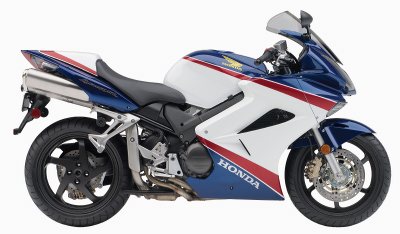
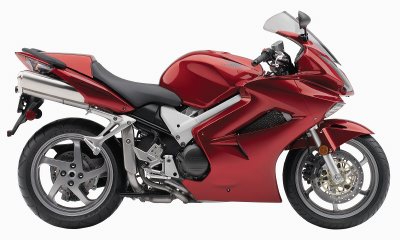
2008 - no change
For 2008 the VFR continues just as it was. The rumour mill continues with talk of a bigger engine (1000cc, 1,000,000cc?) for next year. However, the truth is no-one knows.Recalls
Most of the information below is UK-specific. It appears Honda UK have issued recalls the 2002-on VTEC VFR800 for several potential problems:On the July 2007 oil cooler recall I know of one owner whose letter from Honda informed him that:
"a possibility that water contaminated by de-icing rock salt can penetrate between the oil cooler pipe and its rubber protector. In the worst case, galvanic corrosion of the oil pipe may be generated which could lead to a perforation of the pipe resulting in oil leakage. The possibility of this occurring is extremely low on any machine, especially those that have not been used during such road conditions."Few riders will use their machines in such conditions, but it is important that you get your machine checked. For anyone concerned whether their UK-spec machine is affected you can use the owner pages on Honda's website (which will require you to fill in your address etc) or telephone the Honda UK motorcycle helpline on 01753 590510. If you visit the VOSA recall website make sure you select 'Honda Motorcycles' in the drop-down list.
2009 - repeat after me: "no change"
The three VFR colourschemes for 2009 here.| 2002-on VFR800 | |
| Bore & Stroke Compression Ratio Front wheel Rear wheel Wheelbase Rake/trail Fuel capacity Dry weight (with ABS) UK Colours 2004-2005 colours: 2007 colours: 2008 colours: 2009 colours: |
72 x 48mm 11.6:1 120/70 ZR17 180/60 ZR17 1460mm 25.5°/100mm 22 litres 213kg 218kg Black, Silver, Blue Metallic, Italian Red Winning Red, Digital Silver Metallic, Pearl Heron Blue Black, Burgundy Black, Burgundy, Silver Candy Glory Red, Sword Silver Metallic, Pearl White / Black |
Relevant links
Honda Australia
Motorcycle Daily review
Sportrider.com review, printed the April 2002 issue, includes attractive VTEC wallpapers.